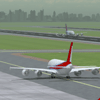As I type code for our upcoming air traffic control games, a question repeatedly comes to my mind. Can a computer manage real air traffic? Could we remove the human factor from radar screens everywhere, and let a computer make these decisions?
A computer is able to observe altitudes, speeds and headings, as well as flight plans. A computer is most certainly capable of broadcasting comprehendable air traffic control instructions to pilots. The coded algorithms required to make such decisions is not rocket science, either. In fact, many of our air traffic control games require some degree of ‘intelligence’ to detect and resolve traffic conflicts. In Airport Madness 3, airplanes see each other and make decisions regarding who should stop and who should go. In our radar game Air Traffic Controller, the system recognizes vertical and lateral losses of separation.

This technology already exists in parts of the world, although it’s focus is high-level enroute situations. How hard is it to change a pilot’s flight level, or give the occasional mach assignment? Passing traffic information would be very easy for a computer. Coordination with other sectors, even human ones, would be spot on. However, I am reminded of a drive I made recently through a remote area of Ontario, Canada. I encountered a complete road closure necessitating a backtrack and a complete reroute to my destination. My GPS (I don’t carry roadmaps) insisted that I get back on the highway in spite of the closure. I had absolutely no way of determining what other routes were available to me and finally had to pull over to get some human advice on how I would reach my destination.
Computers are great, but when the situation is anything but normal a human brain is needed. In air traffic control things are seldom ever normal, except perhaps in the high flight levels where aircraft cruise steadily and predictably. Where things can fall apart are the unusual circumstances, which happen so often in ATC that they become almost expected. Thunderstorm activity, icing, turbulence, emergencies, loss of radar, re-routes, flow control, and airborne holds to name just a few.
Another big reality is the lack of radar information that exists in the world. There is very little coverage out there. If you were to look at a map of the world that depicted areas of radar coverage, most of you would be surprised at how little there is. Granted, they are doing amazing and wonderful things with GPS these days, but at the moment there is very little radar, especially at lower altitudes and away from busy terminal areas. There is almost no radar information over the oceans. Computers make guesses, augmented by position reports from the pilots.
As a programmer, I can’t imagine the amount of code that would be required to detect and handle all of the possible situations that can unfold in the world of air traffic control. In risk of sounding naive, I think this technology is still quite a ways off.





